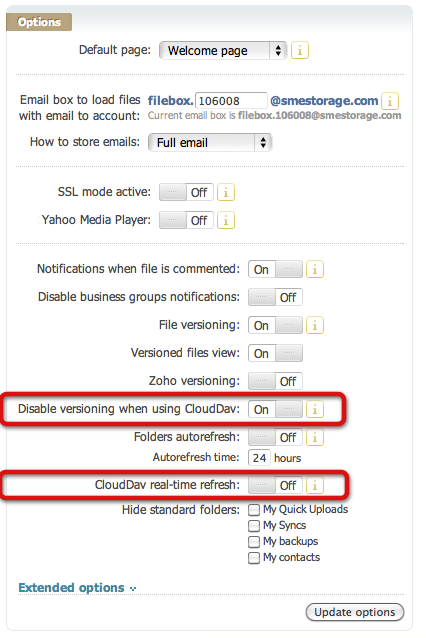Table of Contents
**This is an old revision of the document!**
CloudDav
Last updated on Dec. 11, 2018
Enabling and Configuring CloudDav
We have dropped support for TLSv1.0 and now only support TLSv1.1 and TLSv1.2. This change is in keeping up with the compliance requirements of PCI DSS regarding acceptable encryption.
Windows 7 did not ship with support for TLSv1.1 or TLSv1.2, whereas Windows 10 did. Microsoft does have an article on patching this issue here:
https://support.microsoft.com/en-us/help/3140245/update-to-enable-tls-1-1-and-tls-1-2-as-a-default-secure-protocols-in
Note that we do not test or support our software on Windows 7. The information about Windows 7 is provided on an as-is basis.
Pre-Requisite for Enterprise Appliance: CloudDav is configured and turned on at a package level
CloudDav is the File Fabric implementation of WebDAV with a unique twist, it works over any Storage Cloud mapped to a File Fabric account whether that Storage Cloud is WebDAV enabled or not.
This is made possible by the protocol adaptors that the File Fabric provides to enable public and private storage cloud to be accessible over common protocols.
To use CloudDav once it is enabled for an account:
URL:
https://webdav.storagemadeeasy.com
or
https://webdaveu.storagemadeEasy.com/ (EU Server)
Authentication: Your Enterprise File Fabric username or password
You can use a variety of WebDAV clients or Apps to access Files using CloudDav.
Example of Apps include:
iOS Apps: Pages, Numbers, Keynote, OmniFocus, OmniGraffle, OmniGraphSketcher, WPS Office + others
Android Apps: WPS Office, WebDAV Navigator, X-plore file manager, Total Commander + others
CloudDav Options
 There are two options available to be set after login to the Storage Made Easy website and visiting the “My DashBoard” link on the right sidebar.
There are two options available to be set after login to the Storage Made Easy website and visiting the “My DashBoard” link on the right sidebar.
The first option is whether to disable file versioning if using CloudDav. By default this will be set to “on”. When creating or editing files this stops previous version being kept and versioned.
The second option is whether to always update, on access, the Storage Made Easy cache when viewing files over CloudDav. This means that Storage Made Easy will always check directly with the Clouds that you are using rather than using the cache. This has the advantage that you will always see any new files that you added direct to these Clouds but has the disadvantage that it could be slower on the initial view of each directory.
Things to Note
If you added files externally to your Cloud Provider and you cannot see them via CloudDav then you either need to enable the CloudDav real-time refresh from the CloudDav options available from your Cloud Dashboard on the website, or you need to do a manual refresh of your Cloud Files Cache.. To understand how to do a manual refresh please see here.
SME Encrypted files that are uploaded where the end user holds the encryption key (ie. not stored in SME) are not displayed from a WebDAV client connection as it makes no sense to show them as they cannot be un-encrypted from a standard WebDAV client.
If you are trying to map a network drive using SME CloudDav on any version of Windows from XP onwards then we would recommend you install these registry fixes that solve many issues with Windows WebDAV, including authentication and correct working with Office 2010+.
There is also a blog post specifically for mapping CloudDav using the Windows WebDAV feature at:
https://blog.storagemadeeasy.com/mapping-drives-with-windows-server-clouddav/
